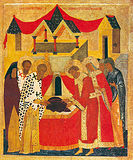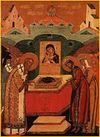

| Previous day | Next day |
| Old Style
July 2
|
Saturday |
New Style
July 15
|
| 6th Week after Pentecost. Tone 4. | No fast.
|
![]() The Placing of the Honorable Robe of the Most Holy Theotokos at Blachernae (5th c.).
The Placing of the Honorable Robe of the Most Holy Theotokos at Blachernae (5th c.).
St. Juvenal, patriarch of Jerusalem (ca. 458). St. Photius, metropolitan of Kiev (1431).
Uncovering of the relics of New Hieromartyr Sergius Florinsky, priest of Rakvere, Estonia (2003).
Icons of the Most Holy Theotokos “Of Akhtyra” (1739) and “The Root of Jesse”.
Martyrs Paul, Bilonus, Theonas, and Heron, at Thessalonica (3rd-4th c.). St. Monegunde of Chartres (Gaul) (530). St. Swithun, bishop and wonderworker of Winchester (862). Right-believing King Stephen the Great, of Moldavia (1504). Hieromartyr Juvenaly of Alaska, protomartyr of America (1796). New Martyr Lampros of Makri in Thrace (1835).
Repose of Archimandrite Lawrence of the Iveron-Valdai Monastery (1876) and Elder Zachariah, schema-archimandrite of St. Sergius Lavra (1936).
Thoughts for Each Day of the Year
According to the Daily Church Readings from the Word of God
By St. Theophan the Recluse

Saturday. [Rom. 9:1-5; Matt. 9:18-26]
The woman with the issue of blood said: If I may but touch His garment, (the Lord’s), I shall be whole, and she received healing according to her faith. We, the sensual, need physical contact in order to receive intangible strength. The Lord arranged things this way. His holy Church has a visible structure. Its various parts embrace us and we touch them. The power of God, found inside the Church, is received through such contact by those who have a receiver—faith, which says: “If I may but touch, I shall be made whole.” The Church is the body and garment of the Lord. The most visible parts, which we touch, are the Divine Mysteries, particularly baptism and Chrismation, the Sacrament of the Lord’s Body and Blood in conjunction with the Sacrament of confession. But contact with all the other aspects can draw needed strength from the Lord, Who is everywhere. He sees each person who does this, and says to his heart, “Be bold, my child!” Free-thinkers, antagonistic toward the external rites of the Church, thus deprive themselves of the opportunity to enter into contact with the inner, divine, all-animating power. This is why they remain sick, and exhausting themselves with the flow of vain thoughts and feelings, they dry up spiritually and die.
Articles
 St Photius the Metropolitan of KievSaint Photius, Metropolitan of Kiev and All Russia, was by birth a Greek from the Peloponnesian city of Monembasia (Malbasia). |
 Icon of the Mother of God of AkhtyrThe Akhtyr Icon of the Most Holy Theotokos appeared on July 2, 1739 in the village of Akhtyr in the area of Kharkov, east of Kiev. |





